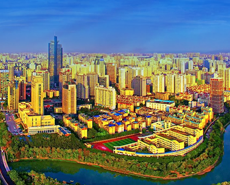
Oversupply triggers continuous low prices of bismuth ingot
----Interview with Zhengjun Xu
General Manager
Hunan Chenzhou Gaoxing Nonferrous Metal Co.
General Manager
Hunan Chenzhou Gaoxing Nonferrous Metal Co.
Founded on 25th June, 2004, Hunan Chenzhou Gaoxing Nonferrous Metal Co. is located in Shizhuyuan Nonferrous Metals Science and Technology Park, Chenzhou City. It owns around 7,326 square meters of land rights and 4,856 square meters of construction area. Its main products include bismuth ingot, lead ingots, matte slag and silver-rich slag. The company makes full use of local resources and has strong capital and technology for backing. The company produces registered trademark "Gaoxing" brand bismuth ingot and electrolytic lead for many years.
Asian Metal: Hi, Mr. Xu! Thank you for accepting the interview. Please make a brief introduction about your company and your personal experience firstly.
Mr. Xu: Founded in 2004, Chenzhou Gaoxing Nonferrous Metals Co. has been focusing on its main product bismuth ingot, with a production capacity of 2,000tpy and an annual output of about 600t. At present, we hold 6 refining pots including 3 pots of 12t and another three of 20t. Gaoxing is located in Chenzhou City, Hunan Province, the main production area of China's bismuth ingot. However, in the recent years, due to the sluggish bismuth industry and thin production profits, surrounding producers gradually quited the market. I began to engage in lead-zinc beneficiation since 1990 and then I gradually came into contact with the bismuth ingot industry, and I have been doing so ever since.


Asian Metal: What are your main raw materials for bismuth ingot and what about the current supply pattern of the raw materials as you learnt?
Mr. Xu: The main raw materials of bismuth ingot include bismuth concentrate, crude bismuth, lead-bismuth alloy and bismuth-containing slag, etc. We mainly uses bismuth concentrate and bismuth-containing slag. Before 2017, the supply of bismuth ingot raw materials kept sufficient, but with the government's increasing focus on environmental protection, hydrometallurgical smelters shut down one after another. The supply of raw materials has gradually tightened since three years ago.
Asian Metal: What are the main distribution areas of bismuth ingot consumption and who are the target customer groups of your company?
Mr. Xu: We mainly sell bismuth ingot to customers in the bismuth oxide industry. The current sales volume can account for around 70% of our annual output, about 400t and we sold the other 30% to some consumers in alloy industry and traders with relatively close relationships. Our current sales is primarily supported by consumers and supplemented by traders. As far as we know, Chinese bismuth ingot producers produce around 1,000t of bismuth ingot a month and more than 12,000t a year. The domestic consumption of bismuth ingot in the field of bismuth oxide exceeds about 60%.


Asian Metal: From the beginning of 2021 to the middle of April, the mainstream prices of Chinese bismuth ingot increased from RMB36,800/t (USD2.58/lb) EXW D/P to around RMB50,000/t (USD3.50lb) EXW D/P. What do you think is the support for this round of price increase?
Mr. Xu: First of all, the main reason for the sharp increase in the prices of bismuth ingot is the inflation after the epidemic. The prices of bulk commodities such as lead and zinc have soared, which driven the prices of bismuth ingot upward. In addition, some large consumers, such as Vital, are also purchasing large volume of bismuth ingot from the spot market. After the Spring Festival, Chinese producers generally faced declined output, resulting in tight spot supply, which further promoted the upward prices of bismuth ingot. However, some traders built stocks at a low level of RMB35,000/t (USD2.45/lb) EXW D/P in 2020, and released them to the spot market at prices over RMB45,000/t (USD3.15/lb) EXW D/P in April and May 2021, which put pressure on the prices of bismuth ingot in the upward channel.
Asian Metal: Entering May, the bismuth ingot market saw panic selling by some traders, and the prices began to fall under pressure. How do you view the price trend from late June to July?
Mr. Xu: Traders started to sell their stocks one after another from early may, and producers also remained very active in selling because of loan pressure in mid of the year. Therefore, in view of oversupply and weak demand, we hold negative attitude to the price trend in June. In July, overseas buyers would start the summer holidays, and purchasing and inquiries would keep inactive, which would further cause the prices to fall and we expect that the prices would go down to around RMB40,000/t (USD2.80/lb) EXW D/P during this period. Of course, if some large consumers continue to purchase bismuth ingot in large volume after repaying their loans during this period, we expect the downward price trend in bismuth ingot market to be reversed.

















